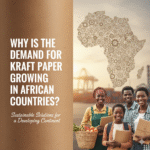Eco-Friendly Alternative to Plastic Packaging
Eco-Friendly Alternative to Plastic Packaging
Eco-Friendly Alternative to Plastic Packaging: In today’s world, one of the biggest environmental problems is plastic waste, which is harming our environment. Instead of plastic, we should use biodegradable materials by Choosing an Eco-Friendly Alternative to Plastic Packaging will help you reduce plastic waste and save time. As more companies are now choosing eco-friendly packaging, this leads to an increased demand for eco-friendly packaging.
The global packaging market was valued at around USD 1,160 billion in 2023 and is expected to reach USD 1,430 billion by 2028, increasing at an annual rate of 4.27%.

Best Eco-Friendly Alternative to Plastic Packaging
| Alternative to plastic | Made up from | Benefits |
| Paper or cloth bags | Cotton, jute | Biodegradable and reusable |
| Aluminum bottle | Glass or recycled aluminum | 100% recycled, reusable |
| Wax-coated Paper | Paper, Waxed Paper, Compostable Films | Keeps food fresh, compostable |
| Paper straws | Food-grade paper | Biodegradable |
| Paperboard Trays | Cardboard | Compostable, |
| Compostable Bags | Cornstarch, Kraft Paper | Breaks down naturally |
| Wooden | Bamboo | Compostable |
| Bamboo | Birchwood | sustainable |
Plastic alternatives and substitutes in the packaging sector:
- Paper and Cardboard
Paper and cardboard are the oldest and best replacements for eco-friendly materials. It is recycled and biodegradable materials, and it is used for packing and wrapping boxes. It’s very cost-effective and easily available in the markets.
Common use:
- Food packaging
- shipping boxes
- product wrapping
- Bagasse (Sugarcane Fiber)
It is a natural product of sugarcane after juice extractions. It is 100% biodegradable, strong, and sustainable. This bagasse packaging easily decomposes within a few months.
Common use
- Plates
- Containers
- Trays
- cups
- Cornstarch Packaging
Cornstarch packing, which is made of fermented plant starch, is very similar to corn or maize. It is biodegradable, renewable, and safe for food use. It’s best for the short term and dry goods. It leaves a much smaller carbon footprint than petroleum-based plastics.
Common use
- Bags
- Cups
- containers
- cutlery.
- Mushroom Packaging
Mushroom packaging is made from agricultural waste and mycelium (fungus roots). This mushroom packaging easily decomposes within a few weeks. It is fully compostable, lightweight, and durable.
Common use
- Protective packaging for electronics
- and fragile goods
- Bamboo Packaging
Bamboo packaging is made from fast-growing bamboo plants. It is renewable, easy to compose, and has a stylish appearance. It is a naturally growing plant without any chemicals.
Common use
- Food containers
- toothbrushes
- Cutlery
- bottles
- Palm Leaf and Areca Packaging
In India, in Southeast Asia, Naturally fallen areca leaves are pressed into shape. It is chemical-free, biodegradable, and compostable within a week. It is 100% eco-friendly.
Common use
- Disposable plates
- Bowls
- food trays
- Bioplastics (PLA, PHA)
Bioplastic is a plant-based plastic that decomposes faster than conventional plastics. It is made of renewable plant materials such as sugar cane, potatoes, and corn.
Common use
- Bottles
- wrappers
- film packaging
- Recycled Paper Void Fillers
It is made from recycled paper to replace bubble wrap or foam. It helps to reduce waste, is recyclable, and is energy-efficient. These are shredded pieces of paper used to fill the space in the box to keep the product safe.
Common use
- Shipping boxes
- Fillers
- Wrapping
- Cotton and jute bags
Cotton and jute are made from natural materials, so they are safe for the environment. It is reusable, durable, and eco-friendly. This is the reason many stores and brands are now preferring these bags. It is used in retail and grocery shops.
Common use
- Shopping bags
- product packaging
- Glass packaging
Glass packaging is the safe option available today. It is 100% recyclable and reusable without losing quality. Glass keeps the products safe and fresh. It is heavyweight and long-lasting. It is non-toxic; it does not react with any food or drink.
Common use
- Bottles
- jars
- Containers.
Impact of plastic packaging on the environment:
Plastic packaging is harmful to us and the environment. Plastic has become a part of our daily lives. It is low-cost, reusable, and strong. Plastic does not break down naturally; it stays in the environment for hundreds of years. It’s polluting the soil, river, and ocean. To reduce this damage, adopting eco-friendly alternatives to plastic Packaging is essential for protecting our planet.
| Non biodegradable | It does not break; it stays in the environment for hundreds of years. |
| Pollutes oceans | Plastic waste ends up in the water, which harms the fish and sea animals |
| toxic chemicals | By burning the plastic, it releases the harmful gases, which are harmful to both animals and humans |
| Consumes fossil fuels | Production relies on petroleum, adding to climate change. |
| Health concern | Tiny plastic particles which is now found in food and drinking water |
Advantages of Switching to Eco-Friendly Packaging
| Advantages | Impact |
| Reduces Plastic Waste | Keep the environment clean and reduce pollution |
| Supports Recycling | Reuse the materials and promote a circular economy |
| Saves Energy & Resources | Renewable and biodegradable |
| Improve the brand image | Build trust with the customer |
| Follow the government rule | Follow all the rules set by the government on the plastic bans |
Wrapping up
Choosing a product that does not harm the environment is a big step toward a healthy environment. From the small change, it will contribute to the environment from plastic bags to cotton bags. Adopting eco-friendly packaging alternatives for your business helps reduce waste and protect our planet for future generations.






